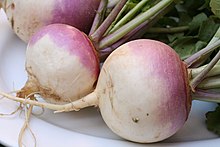Turnip
| Turnip | |
|---|---|
 |
|
| turnip roots | |
| Scientific classification | |
| Kingdom: | Plantae |
| (unranked): | Angiosperms |
| (unranked): | Eudicots |
| (unranked): | Rosids |
| Order: | Brassicales |
| Family: | Brassicaceae |
| Genus: | Brassica |
| Species: | B. rapa |
| Variety: | B. rapa var. rapa |
| Trinomial name | |
|
Brassica rapa var. rapa L. |
|
| Nutritional value per 100 g (3.5 oz) | |
|---|---|
| Energy | 84 kJ (20 kcal) |
|
4.4 g
|
|
| Sugars | 0.5 g |
| Dietary fiber | 3.5 g |
|
0.2 g
|
|
|
1.1 g
|
|
| Vitamins | |
| Vitamin A equiv. |
(48%)
381 μg
(42%)
4575 μg8440 μg
|
| Thiamine (B1) |
(4%)
0.045 mg |
| Riboflavin (B2) |
(6%)
0.072 mg |
| Niacin (B3) |
(3%)
0.411 mg |
| Pantothenic acid (B5) |
(5%)
0.274 mg |
| Vitamin B6 |
(14%)
0.18 mg |
| Folate (B9) |
(30%)
118 μg |
| Vitamin C |
(33%)
27.4 mg |
| Vitamin E |
(13%)
1.88 mg |
| Vitamin K |
(350%)
368 μg |
| Minerals | |
| Calcium |
(14%)
137 mg |
| Iron |
(6%)
0.8 mg |
| Magnesium |
(6%)
22 mg |
| Manganese |
(16%)
0.337 mg |
| Phosphorus |
(4%)
29 mg |
| Potassium |
(4%)
203 mg |
| Sodium |
(2%)
29 mg |
|
|
|
|
|
| Percentages are roughly approximated using US recommendations for adults. Source: USDA Nutrient Database |
|
| Nutritional value per 100 g (3.5 oz) | |
|---|---|
| Energy | 92 kJ (22 kcal) |
|
5.1 g
|
|
| Sugars | 3.0 |
| Dietary fiber | 2.0 g |
|
0.1 g
|
|
|
0.7 g
|
|
| Vitamins | |
| Thiamine (B1) |
(2%)
.027 mg |
| Riboflavin (B2) |
(2%)
.023 mg |
| Niacin (B3) |
(2%)
.299 mg |
| Pantothenic acid (B5) |
(3%)
.142 mg |
| Vitamin B6 |
(5%)
.067 mg |
| Folate (B9) |
(2%)
9 μg |
| Vitamin C |
(14%)
11.6 mg |
| Minerals | |
| Calcium |
(3%)
33 mg |
| Iron |
(1%)
.18 mg |
| Magnesium |
(3%)
9 mg |
| Manganese |
(3%)
.071 mg |
| Phosphorus |
(4%)
26 mg |
| Potassium |
(4%)
177 mg |
| Sodium |
(1%)
16 mg |
| Zinc |
(1%)
.12 mg |
|
|
|
|
|
| Percentages are roughly approximated using US recommendations for adults. Source: USDA Nutrient Database |
|
The turnip or white turnip (Brassica rapa subsp. rapa) is a root vegetable commonly grown in temperate climates worldwide for its white, bulbous taproot.
Small, tender varieties are grown for human consumption, while larger varieties are grown as feed for .
In the north of England and Scotland, and eastern Canada (Newfoundland), turnip (or neep; the word turnip is an old compound of tur- as in turned/rounded on a lathe and neep, derived from Latin napus) often refers to rutabaga, a larger, yellow root vegetable in the same genus (Brassica), also known as swede (from "Swedish turnip").
The most common type of turnip is mostly white-skinned apart from the upper 1–6 centimetres (0.39–2.36 in), which protrude above the ground and are purple or red or greenish where the sun has hit. This above-ground part develops from stem tissue, but is fused with the root. The interior flesh is entirely white. The root is roughly globular, from 5–20 centimetres (2.0–7.9 in) in diameter, and lacks side roots. Underneath, the taproot (the normal root below the swollen storage root) is thin and 10 centimetres (3.9 in) or more in length; it is trimmed off before the vegetable is sold. The leaves grow directly from the above-ground shoulder of the root, with little or no visible crown or neck (as found in rutabagas).
Turnip leaves are sometimes eaten as "turnip greens" ("turnip tops" in the UK), and they resemble mustard greens (to which they are closely related) in flavor. Turnip greens are a common side dish in southeastern U.S. cooking, primarily during late fall and winter. Smaller leaves are preferred, but the bitter taste of larger leaves can be reduced by pouring off the water from the initial boiling and replacing it with fresh water. Varieties of turnip grown specifically for their leaves resemble mustard greens and have small or no storage roots. These include rapini (broccoli rabe), bok choy, and Chinese cabbage. Similar to raw cabbage or radish, turnip leaves and roots have a pungent flavor that becomes milder after cooking.
...
Wikipedia
